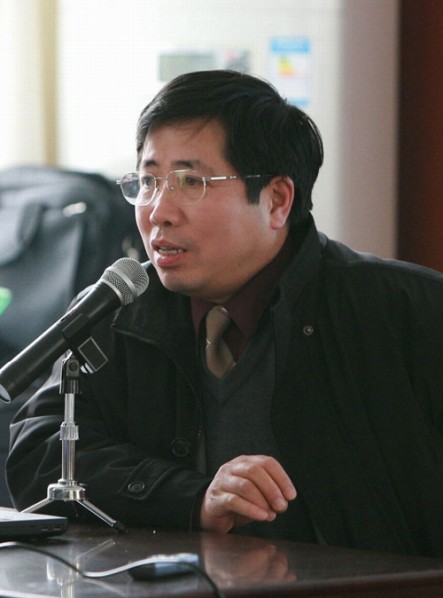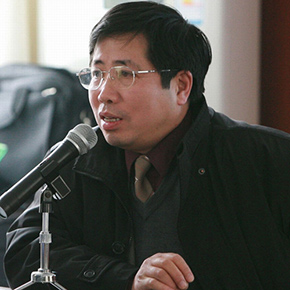Yi Ying

Well-known art historian and art critic Yi Ying was born Zhijiang County in Hunan Province, he graduated from Hunan Normal University, Department of Fine Arts in 1982, and Art History Department of the Central Academy of Fine Arts in 1985. He is currently the professor of the Central Academy of Fine Arts, and the director of CAFA Journal, the editorial director of "Art Studies" , the editor in chief of "World Art Magazine" and the doctoral tutor. Major works include: "School's Twilight" (Hunan Fine Arts Publishing House), "Front Side" (Hunan Fine Arts Publishing House), "Ode to the mundane from the heroic world" (Chinese People's University Press), "World Art Collection: 20th Century Western Art"(Chinese People's University Press),"The Selected Works of World Art"four volumes edition (Hebei Fine Arts Publishing House)," Selected Works of Contemporary Western Art Criticism " two volumes edition (Hebei Fine Arts Publishing House), the main translation works" Panovsky and Base of Art History "(Hunan Fine Arts Publishing House)," Art and Civilization - Cultural History of European Art"(Oriental Publishing Center).
Biography
1953 Born in Zhijiang Dong Nationality Autonomous County, Hunan Province
1982 Graduated from the Department of Fine Art of Hunan Normal University, with a Bachelor degree
1985 Graduated from Department of Art History of CAFA, with a Masters degree
Professor and Master Instructor of CAFA, a famous art historian and art critic
Currently serves as the director of the Editorial Department of the Journal of CAFA, Head of “Art Research” of CAFA, the Editor in Chief of “World Art” of CAFA
Monographs:
“Sunset of Academy” (2001, Hunan Fine Arts Publishing House)
“Case Study of Chinese Contemporary Oil Painters: Liu Xiaodong” (2000, Hunan Fine Art Publishing House)
“From the Heroic Ode to the Ordinary World: Chinese Modern Art Trendy of Thought” (2004, China Renmin University Press)
“Slant: Criticism of Chinese Contemporary Artists” (2004, Hunan Fine Arts Publishing House)
“World Art – Vol.20: Western Art in the 20th Century” (2004, China Renmin University Press)
“Yi Ying’s Quotes” (edited by Fang Xudong, China Literature and Art Publishing House)
“Anthology of ‘World Art’” 4 volumes (Hebei Fine Arts Publishing House)
“Anthology of Western Contemporary Art Criticism” two volumes (Hebei Fine Arts Publishing House)
“Anthology of Western Modern Art Aesthetic·Plastic Art” (1990, Chunfeng Wenyi Chubanshe)
Translations:
“Vision and Design” (Roger Fry’anthology) (1987)
“Landscape of Oil Painting Technique” (1991)
“Panofsky and Art History Foundation” (1992, Hunan Fine Arts Publishing House)
“Drawing Manual” (1995)
“Material and Technique of Oil Painting of Contemporary Artist” (2000, China Youth Press)
“Art and Culture”, (2001, Shanghai Oriental Publishing House)
“Rebellious Thought” (2005, Hebei Fine Arts Publishing House)
Selected Thesises:
“The Confusion of Modernism and Our Choice” (1989)
“Sunset of Academy” (1993)
“The Significance to Strive to Make It Clear” (1994)
“After Modernism and Chinese Contemporary Art” (1996)
Yi Ying Quotes
The Crisis of Original CreationThere is a barrier in the development of oil painting in the 21st Century, but this is veiled by superficial prosperity, that is the market prosperity. It is hard to figure out which style of prosperity is promoted by the market. On the contrary, it is the market and collection that keeps the life of style living for a period after it is down. There are different reasons that lead to a style and a movement or even an art type decaying from prosperity. But there is a basic marker when there is a loss of the vigor of creation and the capability for self-evolution. A large number of real artists give up oil painting and others types of painting, making use of some artistic expressive ways as being without commercial and capital requirements. In contrast, currently oil painting is in a rather poor position.
Chinese Contemporary Art is still developing in a“Western Mode”, as Chinese elements are still controlledIn recent decades, there has been a change in Chinese art so that lots of Chinese elements are used in creations. Influenced by modern Western art in the 1980s, and especially the Chinese economy and culture that participates in the system of globalization in the 1990s, we can see a lot of Chinese elements emerging from the system of globalization which are considered to be a positive phenomenon. This is not a fact, and China is still controlled with a global division of labor. China is without a global dominant discourse, Western countries still dominate the world, i.e. the global culture, in contrary to the national cultures of the Third World. It reveals that the Chinese are not beyond traditional culture, nor beyond the main traditions of Western culture in the current cultural situation, but it is a complex situation with a lot of controversies. The Western culture still formulates the rule of global economy and the global culture, the Chinese economy is developing in accordance with their game, and is always impacted by them.
There are two sides to media reports and Western perspectives. Western art has supported Chinese contemporary artists since the 1990s, such as Zhang Xiaogang, Fang Lijun, etc. While on the other hand, Western art is concerned with Chinese traditional cultures including Chinese elements. It is a fault that Chinese culture has a strong increase, instead, it could intervene in the constraint of Western globalization. In order to enter the Western pattern of globalization, we have to manufacture Chinese products. The so-called Chinese element is the traditional Chinese culture, but not the current Chinese culture. Today, the Chinese elements overwhelm Chinese reality, artists are not concerned about reality, instead, they are looking for traditional cultural symbols, local cultural symbols to create art works. In fact, the most important thing is to practice the relationship of art and reality.
Translated by Chen Peihua and edited by Sue/CAFA ART INFO
























